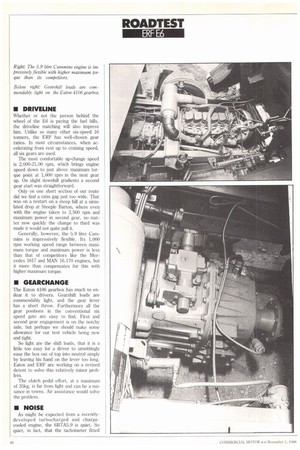ROADTEST
Page 48

Page 49

If you've noticed an error in this article please click here to report it so we can fix it.
ERF E6
Right: The 5.9 litre Cummins engine is impressively flexible with higher maximum torque than its competitors.
Below right: Gearshift toads are commendably light on the Eaton 4106 gearbox.
• DRIVELINE
Whether or not the person behind the wheel of the E6 is paying the fuel bills, the driveline matching will also impress him. Unlike so many other six-speed 16 tonners, the ERF has well-chosen gear ratios. In most circumstances, when accelerating from rest up to cruising speed, all six gears are used.
The most comfortable up-change speed is 2,000-21,00 rpm, which brings engine speed down to just above maximum torque point at 1,600 rpm in the next gear up. On slight downhill gradients a second gear start was straightforward.
Only on one short section of our route did we find a ratio gap just too wide. That was on a restart on a steep hill at a simulated drop at Steeple Barton, where even with the engine taken to 2,500 rpm and maximum power in second gear, no matter now quickly the change to third was made it would not quite pull it.
Generally, however, the 5.9 litre Cummins is impressively flexible. Its 1,000 rpm working speed range between maximum torque and maximum power is less than that of competitors like the Mercedes 1617 and MAN 16.170 engines, but it more than compensates for this with higher maximum torque.
• GEARCHANGE
The Eaton 4106 gearbox has much to endear it to drivers. Gearshift loads are commendably light, and the gear lever has a short throw. Furthermore all the gear positions in the conventional six speed gate are easy to find. First and second gear engagement is on the notchy side, but perhaps we should make some allowance for our test vehicle being new and tight.
So light are the shift loads, that it is a little too easy for a driver to unwittingly ease the box out of top into neutral simply by leaving his hand on the lever too long. Eaton and ERF are working on a revised detent to solve this relatively minor problem.
The clutch pedal effort, at a maximum of 35kg, is far from light and can be a nuisance in towns. Air assistance would solve the problem.
• NOISE
As might be expected from a recentlydeveloped turbocharged and chargecooled engine, the 6B1'A5.9 is quiet. So quiet, in fact, that the tachometer fitted as standard in the E6 will be much used by any driver aiming to get the best from the engine.
From outside the cab the 'B' series' exhaust note is similar to that of its big 10litre brother. Inside the cab, noise levels stay pleasingly low right up to the engine's governed speed.
• CAB COMFORT
The new, 'E series cab, introduced earlier this year, has four point suspension which helps to insulate driver and passenger from noise, as well as from road bumps, shocks and vibrations. Our test vehicle has the day cab 'E' series variant. A so-called night cab, dimensionally the same as the day cab but with a folding bunk and curtains, is also available for the E6, as is a short day cab which allows an extra 127mm of body length.
The 'E' series cab was first offered in sleeper form on tractive units. The day cab on the new 16 tonner has the same new facia and virtually identical trim level, although steering wheel rake and height adjustment is an option on the rigid.
Features of the 'E' series cab that we particularly like are the easy-to-read instrument panel, sensibly proportioned and clearly marked rocker switches and excellent ventilation system. The heater is almost too effective — even the smallest movement of the temperature control lever sent the in-cab temperature soaring even without using the heater fan, which suggests that the maximum output of the `E' series heater is probably adequate for Arctic conditions!
The engine hump in the E6 cab is very shallow, making it relatively easy for the driver to move across the cab to the nearside.
This can be an important consideration for a vehicle used on multi-drop work in busy urban streets. Ease of access to the driver's seat of the E6 is not as good as it might be, as a result of the door not opening to a full 90°.
On useable stowage space for delivery notes, tachograph charts and the various other odds and ends a driver carries, the E6 scores very highly. Its door pockets and behind-the-seat shelf are particularly useful.
• BRAKES
Like Volvo's FL6, the E6 has Lucas Girling FCSS foundation brakes, but of an earlier design with manual adjustment. They behaved impeccably in all our tests; the park brake, which held the fully-laden 16 tonner firmly on a 33% gradient, was particulary effective.
An exhaust brake is not yet an E6 option but ERE hopes to have one available soon.
At present the Cummins-recommended exhaust back pressure limit is only 2.5 bar for the '13' series. ERF has found this is not high enough to enable an exhaust brake to be as effective as required; Cummins says, however, that there is no reason for not fitting one to the 'B' series.
• SUMMARY
ERE is evidently more determined than ever to increase its share of the highlycompetitive 16 tonne market. Judging by our test results there is no reason why it should not do so.
The E6.18 is a high quality lightweight 16 tanner, with plenty of driver appeal and an outstandingly well-matched driveline. We have yet to test a 16 tonner which can do as well in so many performance areas. Furthermore the E6 is competitively priced, and in a few months time a cleverly-engineered dropframe version will be available ex-factory. 0 by Tim Blakemore




















































































